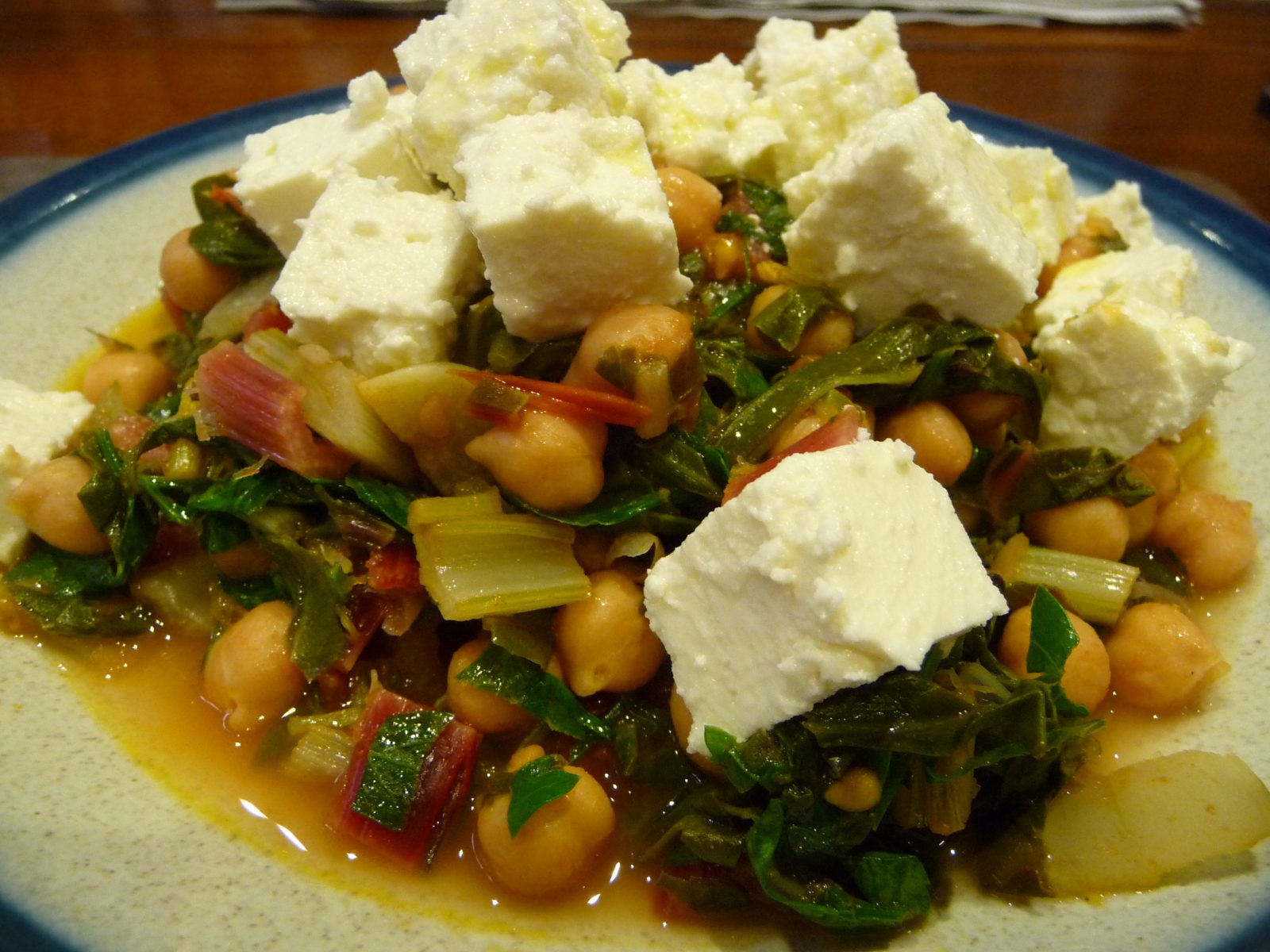
This delicious recipe, featured in The Guardian recently, is by Rachel Roddy. I served it with feta cheese crumbled over the top.
Serves 4
Preparation time: 15 minutes
Cooking time: 15-20 minutes
Ingredients
250g dried chickpeas, soaked and cooked, or 400g tinned chickpeas, drained
600g chard
12 cherry tomatoes
6 Tbsp extra virgin olive oil, plus more for serving
2 garlic cloves
salt and black pepper
A handful of parsley, chopped
juice of 1/2 lemon
Ricotta, feta, goat’s cheese, lamb chops, or a poached egg, to serve
Method
Wash the chard and cut the stems from the leaves, trimming tough ends and pulling away any stringy bits. Cut the stems into short lengths, then roll the leaves into cigars and chop roughly.
Bring a large pan of water to the boil, add salt. Add the stems for 1-2 minutes, then add the leaves for a few minutes more or until tender. Drain.
Warm the olive oil over a medium-low heat. Peel and crush the garlic for a milder flavour, or slice for a stronger hit. Add to the pan with the cherry tomatoes. Fry, squashing the tomatoes gently with the back of a spoon, until they are soft and the oil is tinted red. Add the chard and stir until it glistens with oil, add the chickpeas and cook for a few minutes more.
Remove from the heat, add the parsley, lemon juice, salt and pepper, then let it sit for a while. Before serving, check seasoning, and pour over a little more oil.
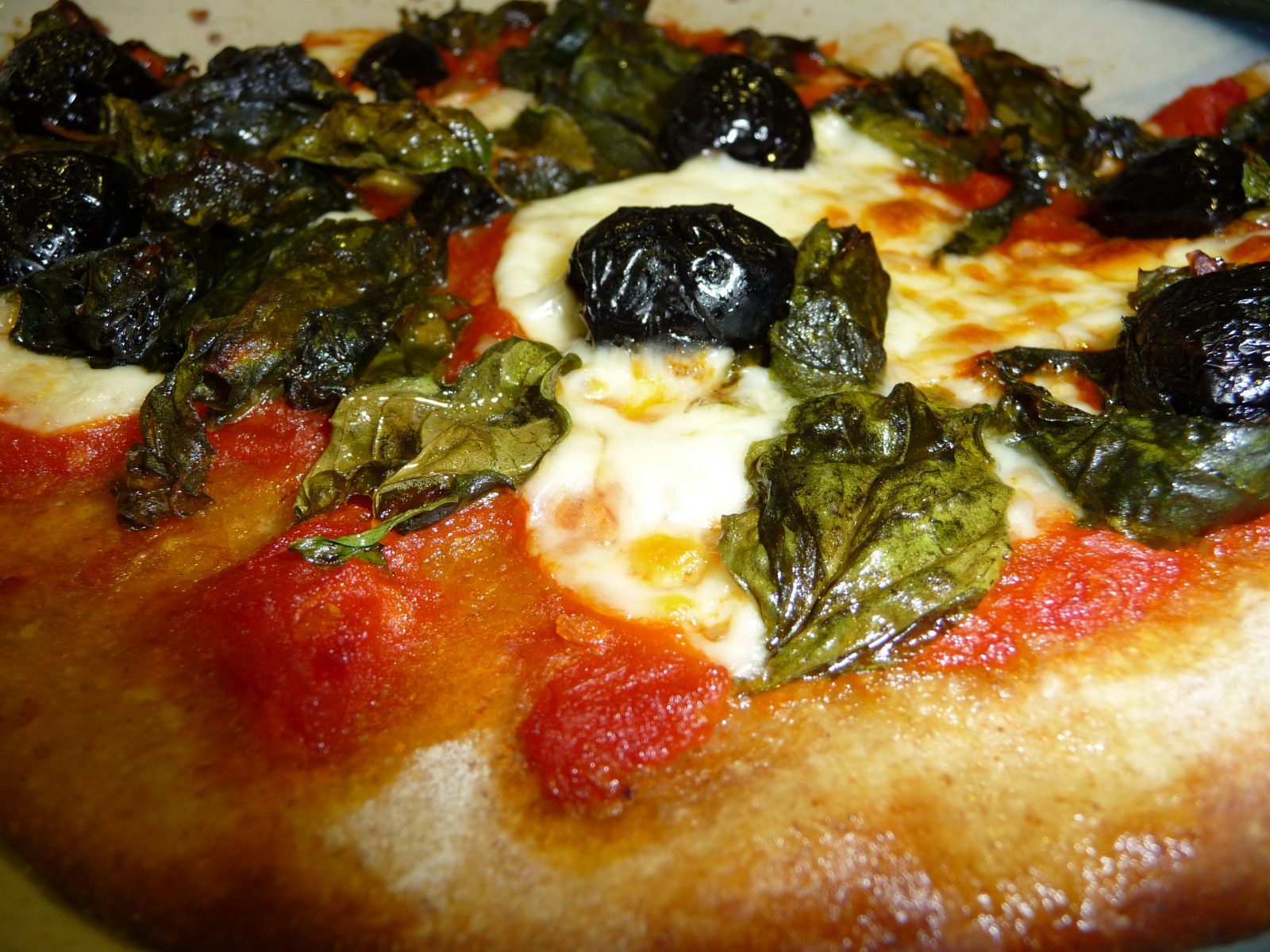
My husband in his quest to create the perfect sourdough pizza adapted a recipe from London pizzeria Franco Manca‘s book Artisan Pizza To Make Perfectly At Home. They use wild broccoli or friarelli, but Frank used chard from this week’s veg box. Choose your favourite pizza base (Frank makes a sourdough base from scratch but you might prefer to buy one!) and then cook the pizza as you would normally.
Serves 4
Preparation time: 15 minutes
Cooking time: 30 minutes
Ingredients
4 pizza bases
200g chard leaves
1 tbsp olive oil
1 garlic clove, crushed
1 red chilli, finely chopped
sea salt
For the tomato sauce:
1 can plum tomatoes, ‘mashed’ by hand and ‘lumpy bits’ removed
1 garlic clove, finely grated
1 tbsp olive oil
1 mozzarella cheese
black olives
basil leaves
Method
To make the tomato sauce, heat the oil in a pan, ad the grated garlic and fry gently for 2-3 minutes. Add the tomatoes and cook until reduced by about 50%. Remove from the heat and leave until needed.
In another pan, heat the olive oil and fry the garlic and chilli over a medium heat. Add the chard leaves, some salt and a drop of water and cover. Cook for about 4 minutes. Drain well and squeeze excess water from the leaves before using.
Spread the tomato sauce over your pizza bases. Lay some chard down on the pizzas and then top with mozzarella, olives and basil. Cook the pizzas in your usual way.
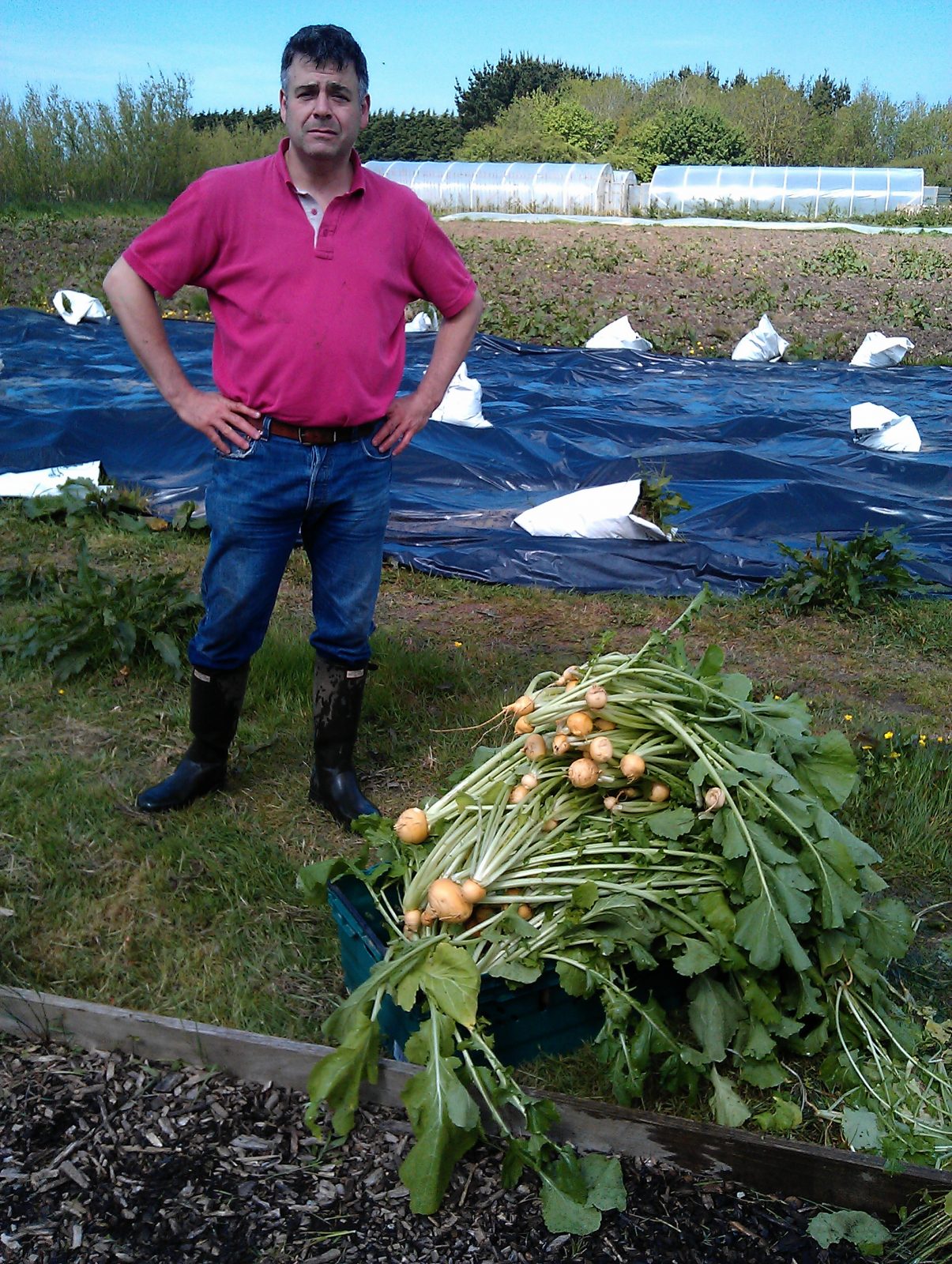
An extremely versatile vegetarian dish that uses up the last of the winter season’s swede in this week’s veg boxes. You can use turnips or swede or a mixture of both. The same goes for spinach and chard.
As Nigel says: “This gently fragrant dish works well with potatoes and parsnips, too. You could use another leaf, perhaps chard or kale.” It comes from his Mid-week dinner feature in The Guardian.
Serves: 6
Preparation/cooking time: 20 minutes
Ingredients
1kg mixed turnips and/or swede
1 onion, finely chopped
knob of butter
1 tsp oil
1 tsp each of cumin seeds, ground turmeric and garam masala
200g spinach or chard
yogurt and coriander leaves, to serve
Peel turnips and swede and cut them into large pieces. Cook the turnip and swede either in boiling, lightly salted water, or in a steamer, until tender.
In a shallow pan, fry a peeled and roughly chopped onion in a little butter and oil until soft and golden, then add the cumin seeds, ground turmeric and garam masala. Continue cooking for a couple of minutes at a moderate heat until all is fragrant.
Wash and remove any tough stalks from 200g of spinach or chard. Place a nonstick, shallow pan over a moderate heat, add the wet spinach and cover with a tight-fitting lid. Let the spinach cook in its own steam for about three minutes, until wilted, then drain and gently press the water from it.
Add the drained turnips and swedes to the onions and continue cooking until they are lightly golden and have soaked up some of the flavour for the spices. Season with a little salt. Fold the spinach into the spiced turnips and swede and serve, if you wish, with a trickle of yogurt and a few coriander leaves. Serves 4.
Nigel’s trick: “Steam your spinach rather than boiling it. The best way I have found is to wash the leaves and, while they are still very wet, put them in a shallow pan to which you have a tight-fitting lid. Place over a moderately high heat, cover and let the spinach cook for a minute or two in its own steam. Lift the lid, turn the leaves with a pair of tongs or a draining spoon, then cook them for a minute more. I find this gives a better result than boiling.”
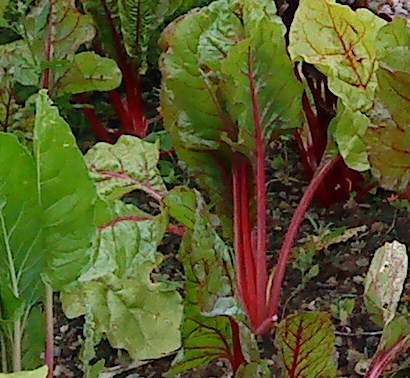
This recipe is from Leon’s Fast Vegetarian which my son very kindly bought me for my birthday last year because he thought it might give me inspiration for the weekly recipe. I will be using some of the chard from our box this week to make it.
Serves 4
Preparation time: 10 minutes
Cooking time: 20 – 30 minutes
Ingredients
150 ml white wine
2 cloves garlic, crushed
2 red chillies, deseeded and chopped
300g peas (frozen are fine)
150 ml water
100g chard, washed
salt and freshly ground black pepper
440g orecchiette
2 Tbs flat leaf parsley, chopped
extra virgin olive oil for drizzling
Method
Put the wine, garlic and chilli into a large pan and bring to the boil, then reduce the heat and simmer until the volume has reduced by half. Add the peas to the pan with the water and simmer for 2 minutes. Next add the chard and stir quickly to wilt, then remove from the heat. Remove half the pea/chard mix from the pan and blitz in a blender or food processor, then return it to the pan, stir and season well. Bring a large pan of salted water to the boil. Add the pasta and cook for about 10-12 minutes (or according to the instructions on the packet), then drain. Toss the pasta with the sauce, add the parsley and mix well. Season and serve drizzled with good olive oil.
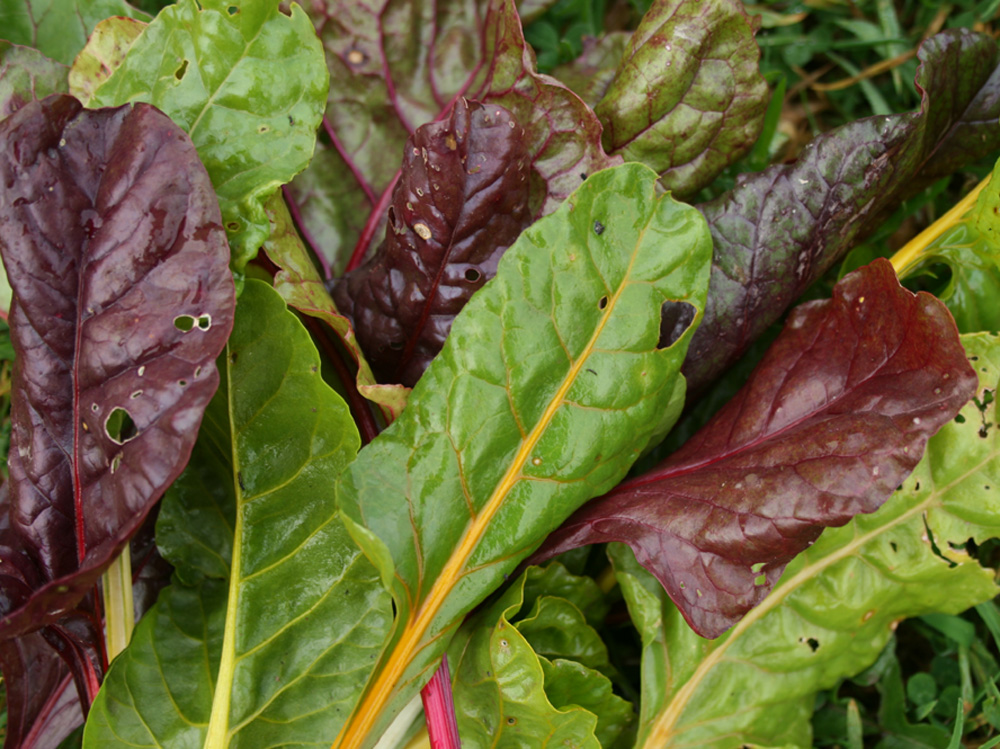
I made this for tea on Friday – it has to be said that swiss chard is not one of my husband’s favourite vegetables but after he had polished off a second helping he said I could make it again! I cheated and used ready-made and ready rolled pastry! It is from the Riverford Farm cook book.
Serves: 4
Preparation time: 45 minutes
Cooking time: 15 minutes
Ingredients
300g shortcrust pastry
50g butter
3 small onions, finely sliced
leaves from 1 sprig of thyme
300g swiss chard
10 olives, chopped
3-4 tbs creme fraiche
1/2 tbs freshly grated parmesan cheese
sea salt and freshly ground black pepper
Method
Roll out the pastry on a lightly floured surface and place on a baking sheet, prick with a fork in several places and chill for 15 minutes (it doesn’t need to be a uniform shape). Place in a pre-heated oven 200°C/gas mark 6 and bake for 10-15 minutes, until golden brown. Once the pastry is rolled out you can start to prepare the topping. Heat the butter in a pan, add the onions and thyme and cook gently for about 10 minutes until soft but not coloured. Meanwhile, separate the chard stalks from the leaves and chop both leaves and stalks roughly, keeping them separate. Add the stalks to a pan of boiling water and cook for 2-3 minutes, until tender. Remove the stalks with a slotted spoon and set aside. Add the leaves to the boiling water and blanch briefly. drain well, refresh under a cold tap and then squeeze to remove as much water as possible. ( I actually cooked the chard stalks with the onions and wilted the leaves in the microwave.) Add the chard stalks and leaves to the onions and reheat gently. Season to taste and mix well. Spread the mixture over the pastry base and sprinkle with the chopped olives, parmesan and a few blobs of creme fraiche. Bake in the oven 190°C/gasmark 5 for about 15 minutes, until lightly browned.
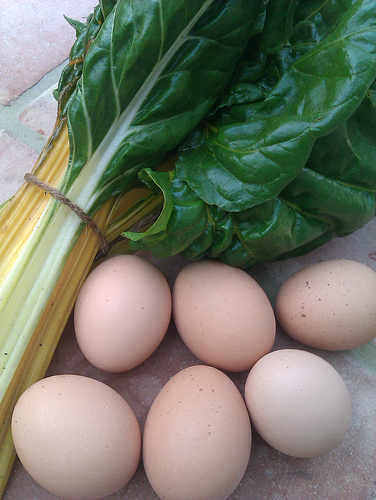
This tasty side dish is from the Riverford Organic Farms’ cookbook. It can also be made with spinach.
Serves 4
Preparation time: 5-10 minutes
Cooking time: 25 minutes
Ingredients
200g cooked chopped chard (or spinach)
1 egg, beaten
200ml double cream
1 tbs grated parmesan
salt and pepper to taste
Method
Mix together all the ingredients. Bake in a gratin dish at 150°C/Gas Mark 2 for about 25 minutes until just set.

This week’s recipe comes from chef Ami Phillips at Relish Food & Drink in Wadebridge. A couple of days ago she created platters of antipasti for the lunchtime menu using the contents of a Camel CSA veg box. Everybody wanted some!
Ami is a graduate of Jamie Oliver’s Fifteen Cornwall restaurant at Watergate Bay. Her food is heavily influenced by Italian cooking and she’s been at Relish for 15 months. She got this recipe while working at Fifteen. It can be done using any type of greens, but is a great use for chard.
Serves: 4
Preparation /cooking time: 15 minutes
Ingredients
4 large handfuls of chard or other greens
3 large cloves of garlic
1 red chilli
olive oil
knob of butter
2-3 tbsp balsamic vinegar
sea salt
black pepper
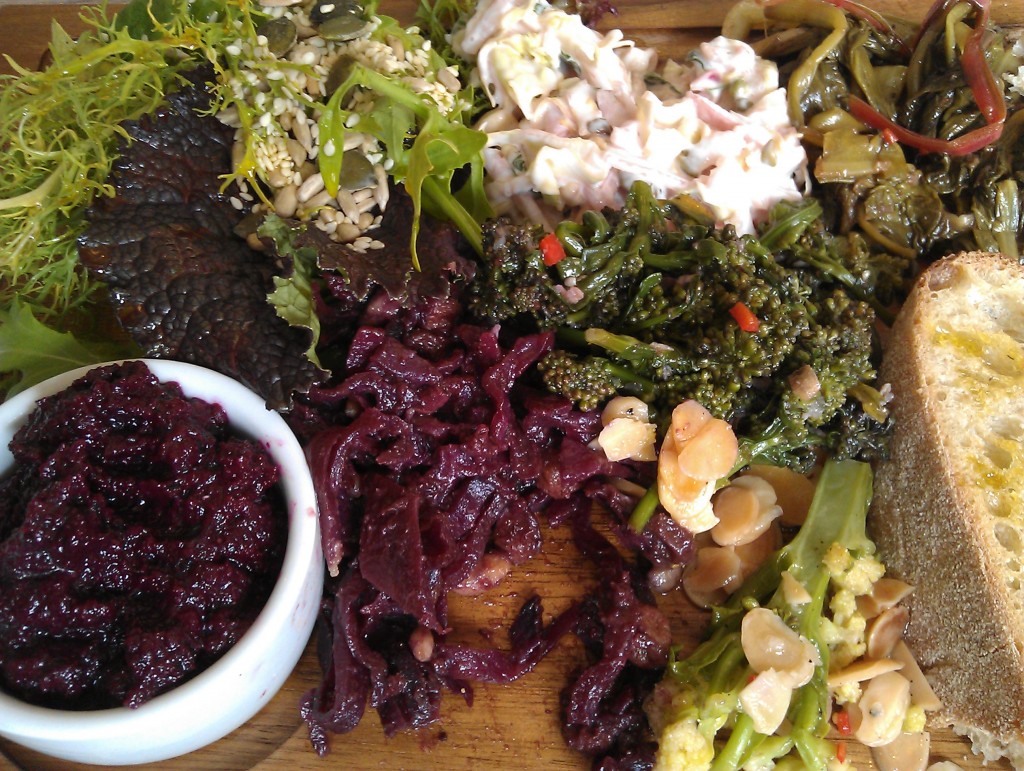
Method
Trim and wash your chard thoroughly. Run a knife down the length of any stalks to ensure faster, more even cooking.
Blanch for 2 minutes in boiling salted water. Tougher winter greens may need longer cooking. Then refresh under cold running water, drain well and set aside.
Grate the garlic cloves, de-seed the red chilli and dice it finely, then put it all in a bowl and cover with olive oil. Heat a frying pan, melt a good chunk of butter and add the chilli and garlic mixture, stirring over a low heat so as to not add colour. Add the chard and 2-3 tablespoons of balsamic vinegar, Cornish sea salt and freshly ground black pepper to taste. Once everything is piping hot, serve!
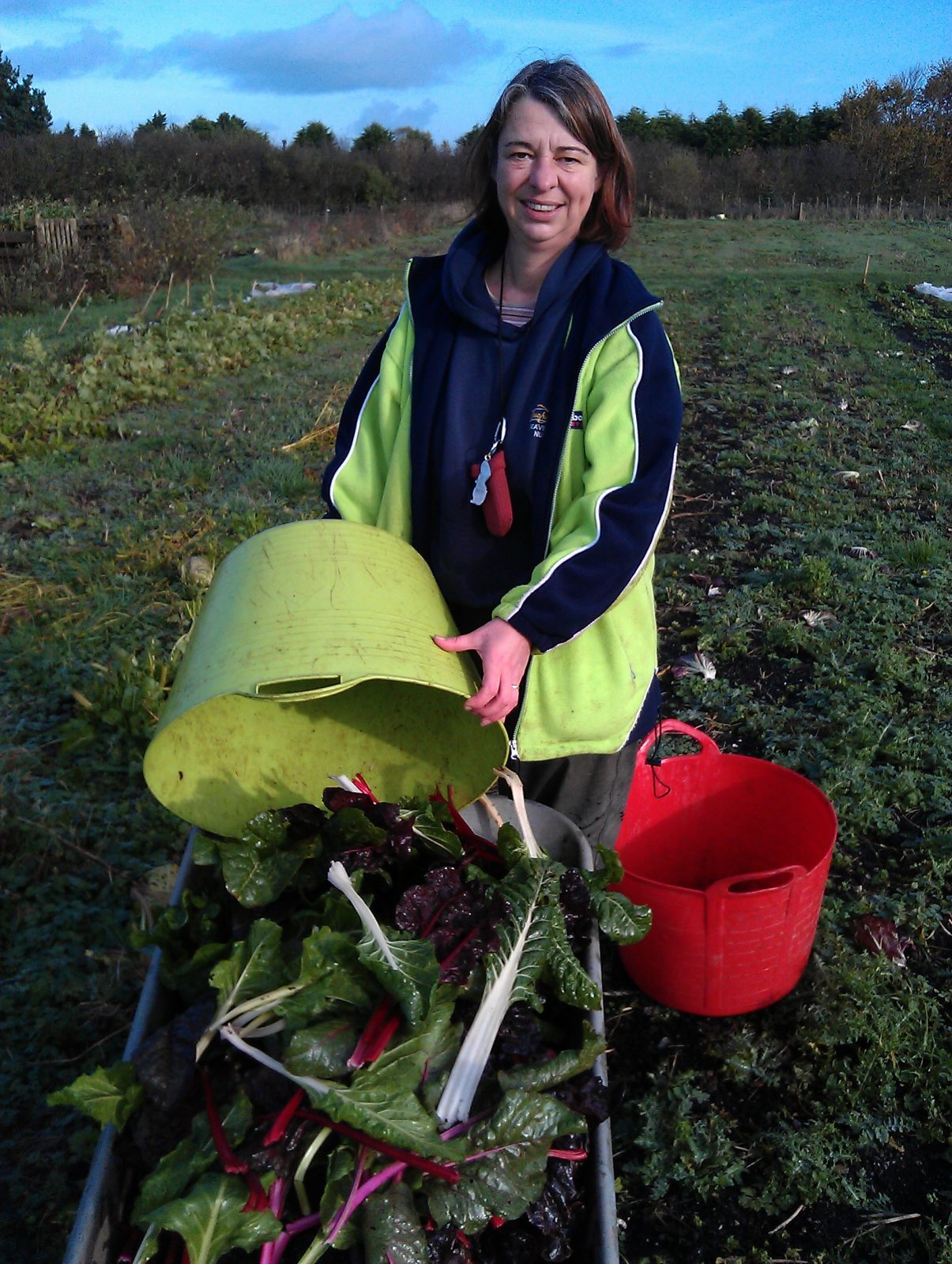
This classic mixture of greens, eggs, cream and bacon comes from Leon Family & Friends by cookery writer Kay Plunkett-Hogge and John Vincent, co-founder of the Leon chain of restaurants.
Serves 6–8
Preparation time: 20 minutes
Cooking time: 50-60 minute
Ingredients
For the pastry
250g plain flour
125g unsalted butter, straight from the fridge, diced
A pinch of sea salt
Small glass of iced water
For the filling
70g lardons or chopped bacon
1 tbsp olive oil
1 garlic clove, finely sliced
100g chard leaves or kale, shredded
2 eggs
1 egg yolk
200ml double cream
100g gruyere cheese
1–2 sprigs of fresh thyme, leaves picked
Salt and black pepper
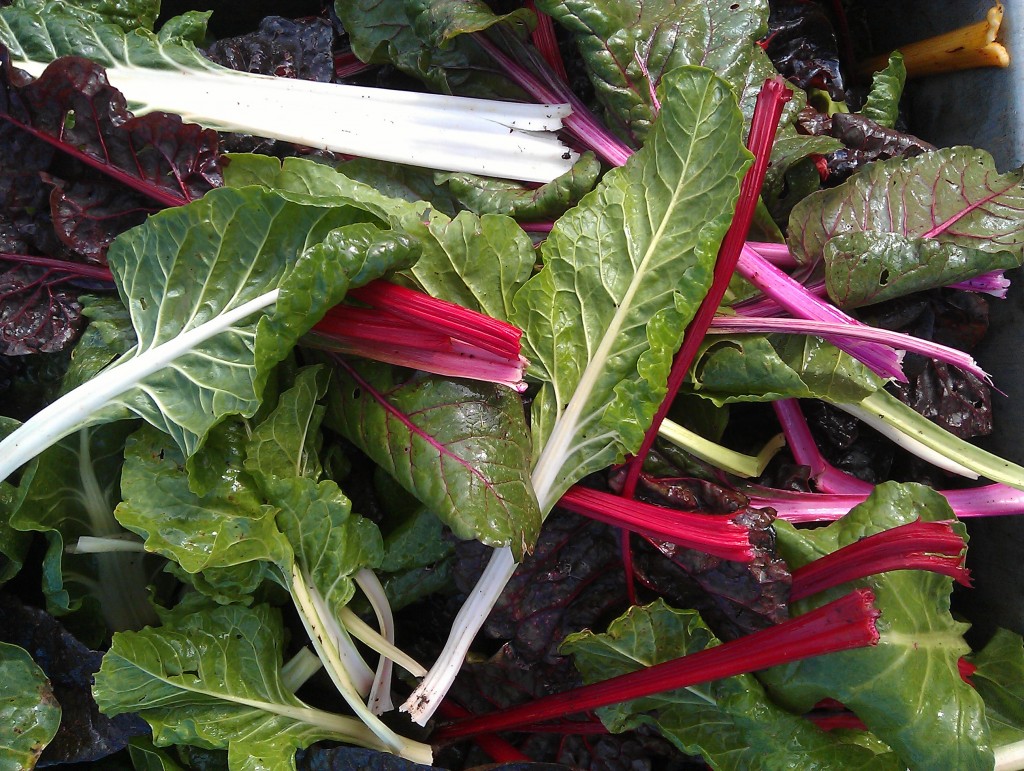
Method
Preheat the oven to 200C/400F/gas mark 6. Butter a 23cm non-stick tart tin with a removable base.
Measure out the flour into a large bowl and add the butter. Start rubbing the flour and butter together until it resembles fine breadcrumbs. Add the salt. Then add the iced water, 1 tsp at a time, until the pastry just comes together. Don’t add too much water or you’ll get a hard pastry.
Roll it into a loose ball and, using your fingertips, gently push the dough into the tart tin, easing it around until it evenly covers the base and sides. Cover the whole thing with greaseproof paper and weigh it down with some baking beans, then blind bake it in the oven for 10 minutes.
Over a medium heat cook the lardons or chopped bacon in a frying pan for about 5 minutes. Remove with a slotted spoon and set aside. Wipe out the pan then return it to the heat and add the oil and garlic. Fry for a minute or so – don’t let it colour too much – then add the chard and a pinch of salt, and cook until just wilted. Remove from the heat, set aside and leave to drain in a colander. When cool, squeeze out any excess liquid.
Take the tart shell out of the oven. Carefully remove the greaseproof paper and the baking beans, and pop it back into the oven for another 5 minutes to crisp up.
In a clean bowl beat the eggs, egg yolk, cream, salt and pepper with an electric whisk. Stir in the gruyere and the thyme leaves and season with salt and pepper.
Remove the tart shell from the oven. Scatter the chard across the base. Sprinkle the bacon bits in then pour in the cream and egg mixture. Bake the tart in the oven for 30–40 minutes until the filling has puffed up and the pastry is a lovely golden brown.

Yotam Ottolenghi is very keen on swiss chard and this recipe is from his latest book Jerusalem, co-authored with Sami Tamimi. Of these fritters, he says, ‘The intense green colour of these fritters , originally Turkish, is paralleled by a wonderfully concentrated “green” flavour of chard and herbs. They are a truly marvellous way to start a meal.’
Serves 4 as a starter
Preparation 10 minutes
Cooking 10 minutes
Ingredients
400g swiss chard leaves, stalks removed
30g flat-leaf parsley
20g coriander
20g dill
1½ tsp grated nutmeg
½ tsp sugar
3 tbsp plain flour
2 garlic cloves, crushed
2 medium eggs
80g feta, broken into small pieces
60ml olive oil
1 lemon, cut into 4 wedges
salt and black pepper
Method
Bring a large pan of salted water to the boil, add the chard and simmer for 5 minutes. Drain the leaves and squeeze them well until completely dry. Place in a food processor along with the herbs, nutmeg, sugar, flour, garlic eggs, salt and peppeer. Blitz until smooth and then fold the feta through the mix by hand.
Pour a tablespoon of oil into a medium frying pan. Put over medium-high heat and spoon in a heaped tablespoon of mixture for each fritter. Press down gently to get a 7cm wide and 1cm thick fritter. You should be able to fit about three at a time. Cook for 3-4 minutes in total, turning once, until the fritters have taken on some colour. Transfer to kitchen paper then keep each batch warm while you cook the remaining mixture. Serve at once with a wedge of lemon.
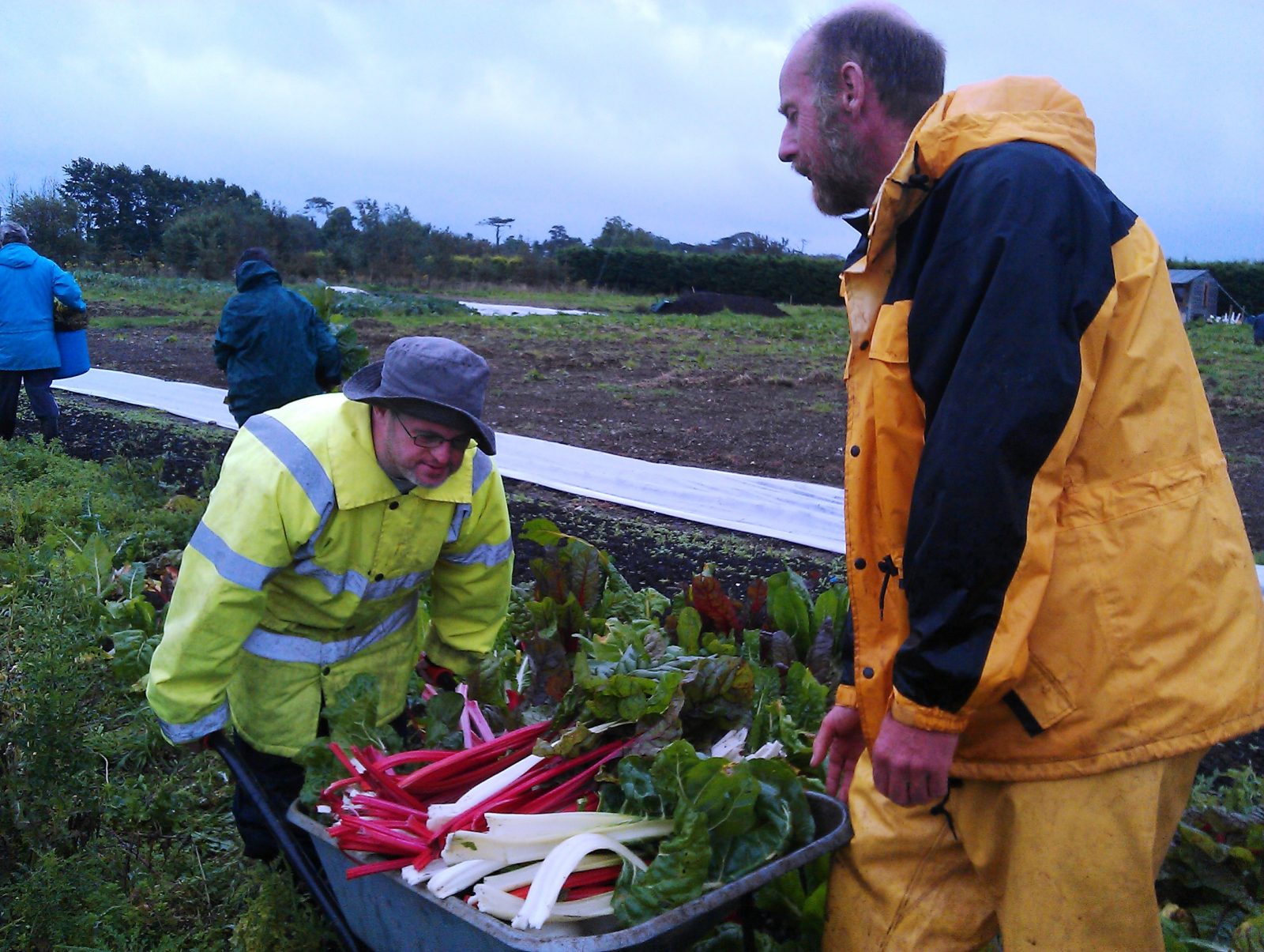
One vegetable that thrives during a wet English summer is Swiss chard. Camel CSA has a huge bed of it in rainbow colours and the picking usually involves us in a big team effort.
Hugh Fearnley-Whittingstall says: “This hearty dish gives chard the cauliflower cheese treatment. It makes a side dish to chops or sausages, but I’d happily eat it as a main course with a hunk of bread.”
Serves: 4
Preparation time: 15 minutes
Cooking time: 40 minutes
Ingredients
About 750g chard
Small knob of butter
About 50g breadcrumbs
A little rapeseed or olive oil
Sea salt
Freshly ground black pepper
For the sauce:
300ml whole milk
½ onion, peeled and cut in two
1 bay leaf
A few black peppercorns
20g unsalted butter
20g plain flour
75g strong, mature cheddar, grated
25g parmesan or vegetarian alternative
(or mature hard goat’s cheese, grated)
¼ tsp English mustard

Method
Heat the oven to 190C/375F/gas mark 5 and lightly grease a shallow, ovenproof dish.
For the sauce, put the milk into a saucepan with the onion, bay and peppercorns. Bring to just below simmering point, turn off the heat and leave to infuse for at least 30 minutes, and an hour or two, ideally.
Meanwhile, separate the chard leaves from the stalks, and cut the stalks into 1.5cm slices. Bring a large pan of salted water to a boil, drop in the leaves and blanch for a minute or two, until just wilted. Remove the leaves with tongs, drain and, when cool enough to handle, squeeze out excess water with your hands, then roughly chop. Meanwhile, drop the chopped stalks into the boiling water and blanch for three to four minutes, until just tender. Drain, toss with a knob of butter, season and spread over the base of the oven dish.
If the infused milk has cooled completely, warm it gently, then strain into a jug. Melt the butter for the sauce in a medium saucepan over a fairly low heat, then stir in the flour to form a smooth paste (a roux). Cook gently, stirring frequently, for a minute or two. Remove from the heat and add a third of the milk. Stir vigorously with a wooden spoon or whisk until you have a thick, smooth paste. Add the rest of the milk in one or two lots, stirring it in until smooth.
Return the sauce to the heat and bring to a boil, stirring. Let it bubble for two minutes, stirring every now and then, to “cook out” any taste of raw flour, then turn the heat right down. Add the cheeses and mustard, stir gently until they melt into the sauce – don’t let the sauce boil, or it may curdle – and season.
Stir the chopped chard leaves into the hot cheese sauce and pour over the stalks in the dish. Scatter with the breadcrumbs and a trickle of oil, and bake for 20 minutes, until golden and bubbling.
- This recipe from is similar to one of my favourite comfort dishes – Swiss chard and potato gratin.


